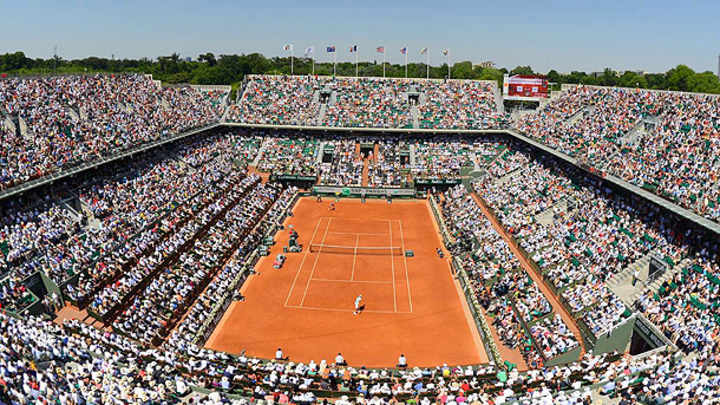How Roland Garros prepares and maintains the clay for the French Open

The clay courts at Roland Garros require quite a bit of maintenance throughout the French Open. (Bob Martin/SI)

The four layers that makes up the courts at Roland Garros may surprise you a bit. You’ll find a 10-inch layer of stone, a six-inch layer of water-filtering slag (metal waste material) and a four-inch layer of limestone all topped off with three millimeters -- a number just too small to count in inches -- of broken brick. But actual clay? Not a part of the clay courts at Paris’ Roland Garros.
While limestone and brick make up the core of the playing surface, that doesn’t make caring for the world’s most famous clay courts any less challenging, says Roland Garros head groundsman Bruno Slastan.
Getting the facility’s 20 courts ready for the French Open requires special attention to the top two layers. Slastan says his crews rework the white limestone layer every year and then haul in 88,000 pounds of broken brick -- but only during completely dry weather when they have “especially good climatic conditions” -- for the three stadium courts and 17 outer courts.
“The thicknesses of materials are respected,” Slastan says. “That is very important. We strive our hardest to achieve perfection.”
During each match, crews rake the surface and sweep clay off of the lines at the end of each set. At the end of every match, the crew waters the entire court to help the brick retain its color and keep from blowing away. And at the end of the day, each court gets watered once again.
The Roland Garros grounds crew waters the court before the women's semifinals in 2013. (Bob Martin/SI)

“We make a big watering because clay courts need water,” Slastan says. After their nightly baths, the courts are covered. At 6:30 a.m. every tournament day, crews slide off the overnight blanket and give the courts a rude awakening by scraping the courts to “standardize the broken brick” and then spread calcium chloride overtop the brick to encourage the brick to stay wet and retain its red color.
As expected, the heavy use of the courts wears away at the courts, as the clay blows away and makes it way into the locker rooms attached to players’ clothes (just look at all those white socks turned red). To make up the difference, Slastan uses another 11,000 pounds of broken brick to fill in as needed.
Come 2018, when the Roland Garros renovation is scheduled to be complete, Slastan may need some additional brick. A new sunken stadium court -- with nearly 5,000 seats -- will replace the current No. 1 Court, and the four Fonds des Princes courts will be turned into seven competition courts, including one with enough room to house approximately 2,200 spectators.
While the maintenance regiment is the same for each court, crews must pay careful attention to courts 3, 4 and 5 and Suzanne Lenglen stadium court because all four courts are built on concrete slabs—“it is dangerous when it rains”—that can make water drainage a bit tricky.
To help compensate for the courts built on concrete atop a parking garage, Suzanne Lenglen court includes a moisture control system that features two large vats below the court for water recovery. The vats get emptied according to the volume of water in them.
Slastan says the quality of those four courts don’t suffer, though, keeping all 20 Roland Garros courts at an equal playability, even if “clay” gets all the credit for the work of limestone and broken brick.
Tim Newcomb covers stadiums, design and gear for Sports Illustrated. Follow him on Twitter at @tdnewcomb.
